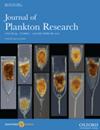RNA/DNA ratios as estimate of metabolic and functional traits in diatom species from the northwestern Adriatic Sea
IF 2
3区 环境科学与生态学
Q2 MARINE & FRESHWATER BIOLOGY
引用次数: 0
Abstract
Different phytoplankton biomass estimations can provide information about abundance variation, but they are not able to describe the metabolic activity of species or groups within assemblages. Conversely, molecular traits are key for the metabolic dynamics in pelagic ecosystems. To investigate if the RNA/DNA and taxon-specific 18S ribosomal RNA (rRNA)/ribosomal DNA (rDNA) ratios could be used to assess and be indicators of metabolic activity in marine phytoplankton species, two Adriatic diatom species, Chaetoceros socialis and Skeletonema marinoi, were studied. Significant correlations between abundance, chlorophyll a, carbon content and proteins were found in individual and co-cultured growth experiments (from rs = 0.570 to rs = 0.986, P < 0.001). The biomass trend followed a logistic curve without providing additional information regarding diatom metabolic activity. In both experiments, the RNA/DNA and taxon-specific 18S rRNA/rDNA ratios of C. socialis and S. marinoi showed maximum values at the beginning of the growth phase, i.e as 23.2 ± 1.5 and 15.3 ± 0.8, and 16.2 ± 1.6 and 30.1 ± 5.4 after 2 and 6 days, respectively, in individual cultures, with a subsequent significant decrease in these values for both species in individual and co-culture experiments. Our results showed that these molecular rRNA/rDNA ratios expressed an activation of metabolism before the abundance increases, even in the presence of interspecific interaction between C. socialis and S. marinoi.亚得里亚海西北部硅藻物种代谢和功能特征的RNA/DNA比值评估
不同的浮游植物生物量估算可以提供丰度变化的信息,但它们不能描述组合内物种或类群的代谢活性。相反,分子特征是上层生态系统代谢动力学的关键。为了探讨RNA/DNA和分类群特异性18S核糖体RNA (rRNA)/核糖体DNA (rDNA)比值是否可以作为海洋浮游植物代谢活性的评价指标,本文以亚得里亚海的两种硅藻——社会毛藻(Chaetoceros socialis)和马里骨藻(Skeletonema marinoi)为研究对象。在个体和共培养生长实验中,丰度、叶绿素a、碳含量和蛋白质之间存在显著相关(rs = 0.570 ~ rs = 0.986, P <0.001)。生物量趋势遵循logistic曲线,没有提供有关硅藻代谢活性的额外信息。在两个实验中,社会金雀花和marinoi的RNA/DNA和分类群特异性18S rRNA/rDNA比值在生长初期达到最大值,分别为23.2±1.5和15.3±0.8,分别为16.2±1.6和30.1±5.4,在单独培养和共培养实验中,这两个物种的数值均显著下降。我们的研究结果表明,在丰度增加之前,这些分子rRNA/rDNA比值表达了代谢的激活,即使在社会金蝇和马里诺鱼之间存在种间相互作用。
本文章由计算机程序翻译,如有差异,请以英文原文为准。
求助全文
约1分钟内获得全文
求助全文
来源期刊

Journal of Plankton Research
生物-海洋学
CiteScore
3.50
自引率
9.50%
发文量
65
审稿时长
1 months
期刊介绍:
Journal of Plankton Research publishes innovative papers that significantly advance the field of plankton research, and in particular, our understanding of plankton dynamics.
 求助内容:
求助内容: 应助结果提醒方式:
应助结果提醒方式:


